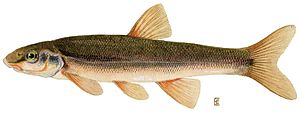Longnose dace facts for kids
Quick facts for kids Longnose dace |
|
|---|---|
 |
|
| Conservation status | |
| Scientific classification | |
| Subspecies | |
|
|
| Synonyms | |
|
The longnose dace (Rhinichthys cataractae) is a small freshwater fish. It belongs to the minnow family. You can find it all over North America.
Its name, Rhinicthys, means "snout fish." This is because of its long snout. Cataractae means "of the waterfall." This part of the name comes from Niagara Falls.
Longnose dace are usually less than 100 millimeters long. That's about 4 inches. They have a fleshy snout that sticks out past their mouth. These fish are great at living on the bottom of fast-moving streams. They hide among the stones. Longnose dace eat tiny plants called algae and water insects. They are also an important food source for bigger fish.
Contents
What Does It Look Like?
Longnose dace can sometimes look like suckers. This is because their mouth is on the underside of their head. It looks a bit like a sucker. But longnose dace are minnows. They do not have small, fleshy bumps called papillae on their mouths. Suckers do have these bumps.
Young dace often have a black line along their side. This line goes from their eye to their tail fin. As they get older, this line usually fades away. Adult dace are dark green or black on top. Their sides are dark or silvery. They often have mottled, or spotty, patterns. Their belly is usually a pearly white color.
Both male and female adults can have bright orange-red colors. You might see this color near their fins and on their upper lip. This bright color is often seen on breeding males. But females can also show this color. So, color is not a sure way to tell if a dace is male or female.
The longest longnose dace ever found was 170 millimeters. But most are much smaller, usually under 100 millimeters.
Where Do They Live?
Longnose dace live in more places than any other minnow in North America. Their range goes from the Rocky Mountains in northern New Mexico. It reaches all the way north to the Mackenzie River near the Arctic Circle. They also live across the continent. You can find them from the Pacific Ocean to the Atlantic Ocean.
This wide range might be because of the last ice age. During that time, large ice sheets covered much of North America. Longnose dace likely survived in several "safe zones." These safe zones are called refugia. There were possibly three main refugia. These were near the Pacific Ocean, the Mississippi River, and the Atlantic Ocean.
Fish in Quebec likely came from the Atlantic refuge. Those in northwestern North America came from a Pacific refuge.
How Do They Live?
Longnose dace like cool water. They live in streams, rivers, and lakes. The water temperature is usually up to 22 degrees Celsius (72 degrees Fahrenheit). These fish live on the bottom of the water. They prefer places with rocks and gravel. During the day, they often hide under rocks.
They like shallow, fast-moving parts of streams called riffles. In lakes, they prefer the choppy water near the shore.
Longnose dace are not picky eaters. They eat whatever they can find. Smaller dace (under 50 mm) mostly eat algae. They also eat small creatures that live on the bottom. Bigger dace (over 50 mm) eat fish scales and fish eggs. They also eat insects that fall into the water. Their diet can change depending on the season.
They usually feed at night. This might be to avoid being eaten by bigger fish. It also helps them avoid competing with other fish like salmon.
Longnose dace usually stay in a small area. They tend to stick to one spot. But some dace have been known to travel very far. Some have moved more than 500 kilometers (310 miles)!
Reproduction and Life Cycle
Longnose dace can start having babies when they are two years old. They usually live for about three years. Males can live up to four years. Females can live up to five years.
They usually lay their eggs from May to August. The water temperature is usually between 14 and 19 degrees Celsius. Some groups of dace lay eggs more than once a year. The exact time they lay eggs depends on the water temperature.
Male dace create and protect small areas. They do this to attract females to lay eggs. The male makes a small dip in the rocky bottom. He then vibrates his body to get a female's attention. If a female is ready, she enters his territory. She pushes her snout into the bottom, just like the male. Both the male and female then tremble over the dip. They release their eggs and sperm. The parents do not usually take care of the young fish after they hatch.
How Human Activity Affects Them
In some areas, like southern Alberta, longnose dace are exposed to certain chemicals. These chemicals come from things like wastewater. For example, downstream from the city of Red Deer, dace are larger. There are also more of them. Their livers are bigger. However, male dace in this area have trouble producing a certain hormone.
Even though these dace look healthy, they are actually stressed inside. This stress is likely caused by chemicals in the water. These chemicals can come from city wastewater, farms, and cattle operations. Scientists are still studying how these chemicals affect the fish.
See also
 In Spanish: Rhinichthys cataractae para niños
In Spanish: Rhinichthys cataractae para niños



